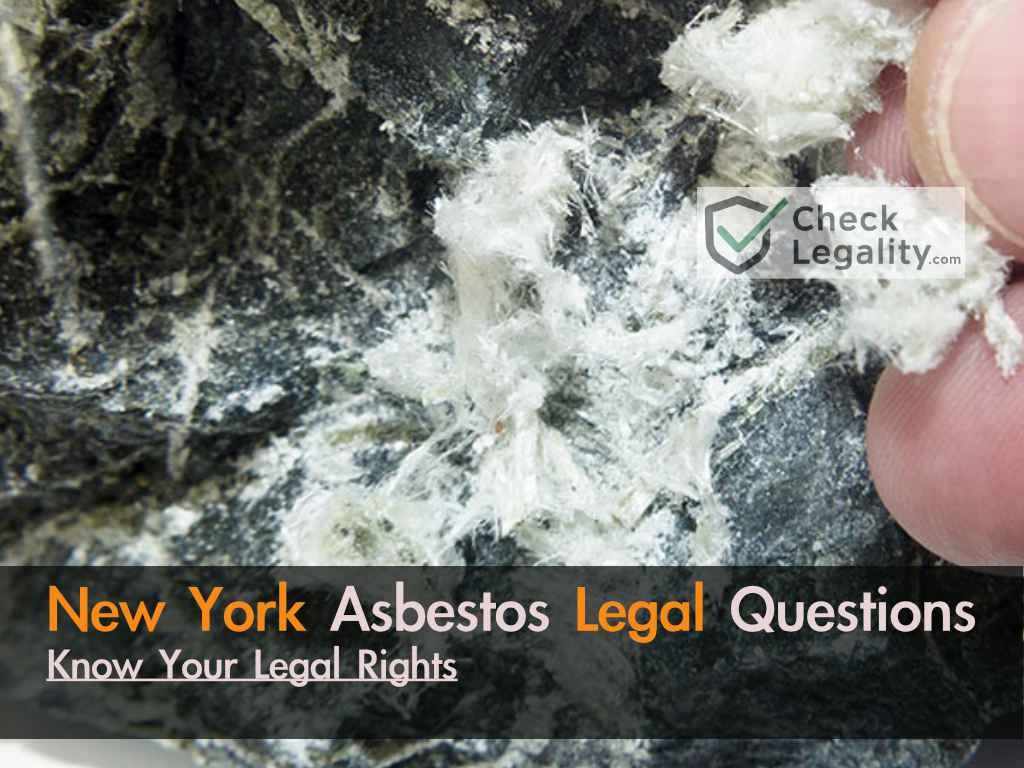Navigating the intricate landscape of New York asbestos legal questions is essential for residents, workers, and property owners confronted with the hazards of asbestos exposure. Asbestos, a once-prevalent material in construction and various industries poses serious health risks when its fibers become airborne and inhaled. In New York, where countless buildings and infrastructure date back to times when asbestos use was rampant, understanding the legal nuances surrounding asbestos exposure, its health implications, and the avenues for recourse is critical. Through this article, we will advise you on the steps to identifying potential asbestos exposure in New York, offering insights into common settings where asbestos may be present and highlighting the importance of recognizing these sources to safeguard your health and uphold your legal rights.
Identifying Asbestos Exposure in New York
In New York, a state characterized by its rich architectural history and bustling construction industry, the risk of asbestos exposure remains a significant concern. Familiarizing yourself with New York asbestos legal questions and Identifying potential sources of exposure is crucial for safeguarding health and ensuring appropriate legal and medical steps are taken if exposure occurs. Here’s a look at common settings and materials where asbestos might be found in New York:
Common Settings for Asbestos Exposure
- Older Residential Buildings: Many residential structures built before the 1980s contain asbestos in insulation, roofing, flooring, and plumbing materials. Renovations, repairs, or damage to these materials can release asbestos fibers into the air.
- Schools and Public Buildings: Similar to residential buildings, older schools and public buildings in New York may have asbestos-containing materials. Maintenance work, structural damage, or specific renovation projects can disturb these materials.
- Industrial and Commercial Sites: Factories, power plants, and shipyards that operated throughout the 20th century often used asbestos extensively due to its fire-resistant properties. Workers in these environments are at a higher risk of exposure.
- Construction and Demolition Sites: If not properly managed, demolishing or renovating buildings can release asbestos fibers. Workers and sometimes nearby residents can be exposed to the dust created during these activities.
Recognizing Potential Exposure Sources
- Construction Dust: Any construction or demolition work in older buildings can create dust that contains asbestos fibers. Recognizing this risk is essential for construction workers and those living near construction sites.
- Deteriorating Insulation: Asbestos was commonly used in insulation materials for pipes, boilers, and in attics. If these materials are old or damaged, they can release asbestos fibers into the environment.
- Ceiling Tiles and Floor Coverings: Many ceiling tiles, floor tiles, and linoleum coverings installed before the 1980s contain asbestos. Disturbance or removal of these materials can lead to exposure.
- Fireproofing and Soundproofing Materials: Asbestos was added to sprays used for fireproofing and soundproofing in buildings. These materials can become friable over time and release fibers with minimal disturbance.
Taking Steps After Potential Exposure
If you suspect you’ve been exposed to asbestos in New York:
- Document the Exposure: Note the date, location, and circumstances of your exposure. This information can be vital for both medical and legal purposes.
- Seek Medical Evaluation: Consult a healthcare professional experienced in asbestos-related conditions. Regular health screenings can help detect any asbestos-related diseases early.
- Consult with Legal Experts: If you believe your exposure resulted from negligence or failure to adhere to safety regulations, speaking with an attorney who specializes in asbestos litigation can help you understand your rights and options for compensation.
Health Risks and the Importance of Medical Documentation

Long-term asbestos exposure can lead to severe health conditions. If you suspect you’ve been exposed to asbestos, seek medical evaluation promptly. Documentation of your condition is not only crucial for your health but also forms the foundation of any legal action you might pursue.
Navigating the Legal Landscape
New York State has stringent laws and regulations governing asbestos use, abatement, and workers’ safety. Familiarizing yourself with these laws, including the right to a safe environment and the specifics of asbestos litigation in New York, is vital.
Steps to Take if You’ve Been Exposed
- Seek Medical Attention: Early diagnosis is key to managing asbestos-related conditions.
- Document Your Exposure: Keep records of potential exposure sites and any related medical reports.
- Consult a Specialized Attorney: Legal professionals experienced in asbestos cases can offer guidance tailored to your situation.
- Understand Your Compensation Options: Explore avenues for compensation, including personal injury lawsuits, workers’ compensation claims, or asbestos trust funds.
Choosing the Right Legal Representation
Selecting an attorney with expertise in asbestos litigation in New York is crucial. Look for professionals with a track record of handling similar cases, understanding the state’s specific legal nuances, and offering compassionate, comprehensive counsel.
What to Expect From Legal Proceedings
Legal processes for asbestos-related claims can vary, involving steps from filing a claim to potentially reaching a settlement. Your attorney will navigate these steps, aiming to secure compensation for medical costs, lost wages, and other damages.
When embarking on legal proceedings related to asbestos exposure in New York, it’s important to have a clear understanding of what the journey might entail. The process involves several key steps and considerations, from the initial filing of a claim to the resolution, whether through a settlement or a court decision. Here’s what you can expect:
Initial Consultation
- Meeting with Your Attorney: This first step involves discussing your case with a legal professional experienced in asbestos litigation. You’ll provide details about your asbestos exposure and any related health conditions. This meeting helps the attorney assess the viability of your case and outline possible legal strategies.
Case Preparation
- Gathering Evidence: Your legal team will collect all necessary evidence to build a strong case. This includes medical records confirming your asbestos-related condition, documentation of your exposure history, and any other relevant information that can establish negligence on the part of the defendants.
- Filing the Claim: Once the evidence is compiled, your attorney will officially file your claim, marking the formal start of the legal process. The claim will detail your allegations, the damages you’re seeking, and the legal basis for your case.
Discovery Phase
- Exchange of Information: During the discovery phase, both sides (the plaintiff and the defendant) exchange information and evidence related to the case. This might include witness depositions, additional documents, and expert testimony.
- Assessment by Both Parties: This stage allows both sides to evaluate the strength of the case, often leading to settlement discussions if the evidence strongly supports the plaintiff’s claims.
Settlement Negotiations
- Negotiating a Settlement: Many asbestos-related claims are resolved through settlements before reaching trial. Your attorney will negotiate with the defendants to reach an agreement that compensates for your damages, including medical expenses, lost wages, and pain and suffering.
- Decision to Settle or Proceed to Trial: You’ll have the final say on whether to accept a settlement offer. Your attorney will provide guidance based on the strength of your case and the likelihood of a more favorable outcome at trial.
Trial
- Presentation of the Case: If a settlement isn’t reached, your case will go to trial. Both sides will present their evidence, and a judge or jury will make a final decision regarding liability and damages.
- Receiving a Verdict: If the verdict is in your favor, the court will determine the amount of compensation you’re entitled to receive from the defendant(s).
Post-Trial
- Appeals Process: The defendants have the right to appeal the court’s decision, potentially extending the resolution timeline. Your attorney will continue to represent your interests throughout any appeals.
- Receiving Compensation: Once the verdict is finalized or a settlement is agreed upon, the process of disbursing your compensation begins. This can provide much-needed financial relief and support for your treatment and recovery.
Resources and Support for Asbestos Exposure Victims
Numerous resources are available in New York for those affected by asbestos:
- Medical Centers: Specialized treatment centers offer care for asbestos-related conditions.
- Legal Aid: Some organizations provide legal assistance or guidance for those pursuing asbestos claims.
- Support Groups: Connecting with others facing similar challenges can provide valuable emotional support and practical advice.
Conclusion – New York Asbestos Legal Question
n navigating the complexities of New York asbestos legal questions, recognizing the potential sources and settings of asbestos exposure is crucial for safeguarding the health and well-being of New Yorkers. Whether through the renovation of historic buildings, employment in industries with a legacy of asbestos use, or simply residing in areas prone to asbestos risks, understanding where and how exposure can occur is the first step toward protection. Armed with knowledge and vigilance, individuals can better navigate the legal landscape surrounding asbestos in New York. For those facing the challenges posed by asbestos exposure, documenting encounters, seeking medical advice, and consulting with legal experts specializing in asbestos litigation are essential actions. This guide serves as a starting point for addressing New York asbestos legal questions, empowering individuals to seek the justice and support they deserve in the face of asbestos-related concerns.


